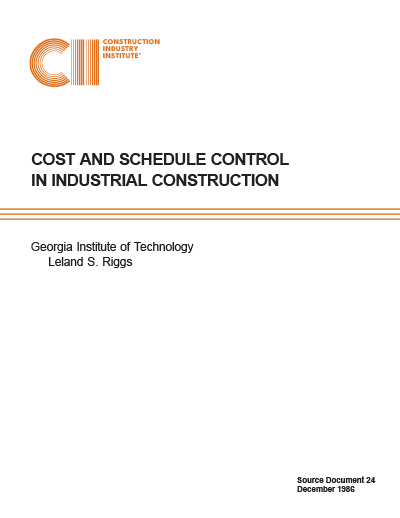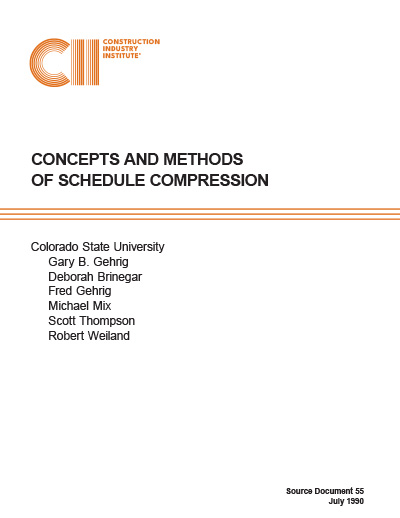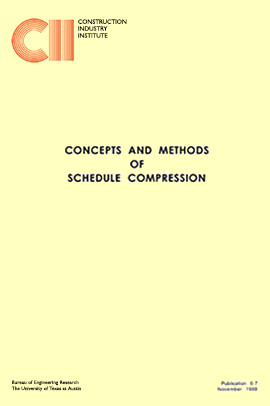
Cost and Schedule Control in Industrial Construction
Origins. This report has its origins in The Business Roundtable’s Construction Industry Cost Effectiveness Project. Report A-6 of this project noted that the construction industry has been slow to adopt up-to-date methods of project control.
Purpose. Our purpose in this research is to identify and report on those cost and schedule control techniques which have been found to be effective. We found no breakthroughs in techniques or technology and we did not expect to. Again, our purpose is to consolidate these techniques and make them available to those who would use them.
Sources. Sources of information for this report were members of the Construction Industry Institute Cost/Schedule Task Force and several owner companies who are also members of the Construction Industry Institute. We selected three owners and four contractors whose techniques seemed to be representative of the state-of-the-art in project control. Also, a literature search was conducted to see if any techniques were emerging which were not in use by the owners and contractors selected for our study. None were found.
Applicability. Although these owners and contractors are engaged primarily in the industrial sector of construction, the techniques noted in our report are transferable to virtually all types of projects. Additionally, while our report focuses on cost and schedule techniques for field control of work, many of these techniques could be applied to the design phase as well.
Organization. Chapters 2 and 3 are descriptions of the cost and schedule techniques of the three owner companies and the four contractor companies. The techniques in these chapters are presented as parts of total project control in these companies.
Chapter 4 is a summary of the techniques discussed in Chapters 2 and 3 categorized under the following headings: Planning, Scheduling, Work Statusing, Trend Analysis, and Forecasting.
Chapter 5 includes a discussion of questionnaires sent out early in this project to Construction Industry Institute members in order to gain a better perspective of the cost and schedule techniques in use. The questionnaires also served to help identify companies which might be appropriate for later interviews.
Chapter 6 is conclusions and recommendations for further study.
Planning Techniques. All the companies in this report had excellent data bases developed over years of experience on similar type projects. These extensive data bases permitted very sophisticated planning in the early stages of a project.
Owners tended to plan for control of only key labor and material items whereas contractors tended to plan for more total control of cost and schedule.
There appeared to be no consensus on the merits of integrating cost and schedule among the owner companies. Most contractor companies seemed to feel that integration was worthwhile.
Both owners and contractors used work breakdown structures to plan and control projects. Contractors, as might be expected, made extensive use of work packages in the field. However, at least one contractor was moving away from detailed control of work packages and was attempting to control projects at a higher level on the work breakdown structure.
Scheduling Techniques. The use of the Critical Path Method (CPM) seemed to be declining. For those who used CPM, no one used below a Level 4 on the work breakdown schedule. Below this level, bar charts were preferred for daily and weekly control.
Generic schedules were popular. These are schedules with the activities and durations established for a typical project. As planning progressed, activities and durations would be modified to fit the project under consideration. No one included in this report used PERT or Line of Balance for schedule control.
Work Statusing Techniques. Generally, this aspect of cost and schedule control was straightforward with owners and contractors using some form of earned value to determine the status of completion.
Trending Techniques. This type analysis was usually based on productivity or performance calculations. Although these calculations were used in a consistent manner in a given company, there was clear evidence of a lack of standardization within the industry as to whether productivity greater than 1.0 was favorable or unfavorable.
Productivity profiles and progress curves were in widespread use. Generally, plots on these curves of actual versus planned progress gave early warning signals of overruns. And, in one instance discussed in this report, actual progress was plotted against both a target and a most probable curve as a recognition of the variability inherent in construction projects.
Forecasting Techniques. Most forecasting techniques were based on the productivity calculations noted above. Usually, no one attempted to forecast until the project was at least 25–30% complete. Further, all of the projection techniques in this report were linear which required considerable judgment in their interpretation.
Computers. An increasing trend toward the use of job site personal computers was evident. In some applications, personal computers were used in a standalone mode and, in others, they were internally developed software was observed but the preference seemed to be for off-the-shelf software. The most prevalent use of these personal computers was in electronic spreadsheets for cost control.
Recommendations for Further Study. Several topics emerged during the course of this report which may be appropriate for further study. One topic concerned the question of: what are the various units of measure for different disciplines on a work breakdown structure? And, what is the level on a work breakdown structure at which these items are controlled in the field?
Another topic which may be of interest for future research is the use of forecasting techniques. As noted above, the techniques used in this report were essentially linear mathematical approaches to the problem. Perhaps there are probabilistic approaches which could be developed to more realistically project final project cost and duration.
During the course of our investigation for this report, we observed the loss of several experienced estimators and schedulers due to early retirement. Should this be a trend, expert systems might be developed to retain the knowledge of these key people.
Finally, we had the opportunity to read many excellent reports during the course of our research. It might be worthwhile to extract pertinent information from these reports and consolidate it into a single reference document.



